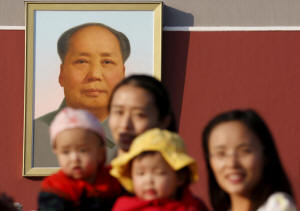China to relax birth policy but wary of social risks, sources say
 Send a link to a friend
Send a link to a friend
 [May 17, 2021]
By Kevin Yao [May 17, 2021]
By Kevin Yao
BEIJING (Reuters) - China will tread
carefully in relaxing its birth policies for fear of harming social
stability, even as the latest census highlights the urgency to address
the country's declining birth trends and ageing population, policy
sources said.
Expectations for birth policy reforms are rising after the 2020 census
last week showed China's population grew at its slowest in the last
decade since the 1950s as births declined and ageing accelerated.
A fertility rate of 1.3 children per woman in 2020, on par with ageing
societies like Japan and Italy, underscores the risk for China: the
world's second-biggest economy may already be in irreversible population
decline without having first accumulated the household wealth of G7
nations.
Top leaders are working out a broader plan to cope with demographic
challenges, the sources said, including more effective ways to encourage
childbearing by easing financial burdens on couples, rather than simply
removing birth curbs.

Raising the retirement age, which Beijing has said will be done
gradually, will help slow a decline in the workforce and eventually ease
pressures on the under-funded pension system, they said.
China introduced a controversial "one-child policy" in the late 1970s
but relaxed restrictions in 2016 to allow all couples to have two
children as it tried to rebalance its rapidly-ageing population. The
change, however, failed to halt declining births.
The sources said they expect Beijing to encourage more childbearing
under the current policy framework, before fully lifting birth
restrictions over the next 3-5 years.
Removing birth restrictions could have unintended consequences: a
limited impact on city dwellers, who are reluctant to have more children
due to high costs, while rural families could expand faster, adding to
poverty and employment pressures, the sources said.
"If we free up policy, people in the countryside could be more willing
to give birth than those in the cities, and there could be other
problems," said a policy source who declined to be identified due to the
sensitivity of the matter.
The sources are involved in policy discussions but not the final
decision-making process.
The State Council Information Office did not immediately respond to
Reuters' request for comment.
China aims to create at least 10 million new urban jobs a year, even as
the working age population shrinks.
Liu Huan, an adviser to the Chinese cabinet, said China's main
population challenge is not size but ageing, which will put heavy
pressure on government finances.
"It's hard to resolve the birth problem given high housing, medical and
education costs," he told Reuters. "So we should have comprehensive
policies."
[to top of second column]
|

Two women and their babies pose for photographs in front of the
giant portrait of late Chinese chairman Mao Zedong on the Tiananmen
Gate in Beijing November 2, 2015. REUTERS/Kim Kyung-Hoon

CALLS FOR CHANGE
The People's Bank of China (PBOC) has in recent weeks become more
vocal about the sensitive population issue.
In April, the PBOC said in a working paper that China should "fully
liberalise and vigorously encourage childbirth" to offset the
economic impact, saying China should draw lessons from Japan's "lost
20 years".
The demographic shifts could lead to economic stagnation, a falling
savings rate and asset price deflation, while the current pension
system is ill-prepared for the ageing trajectory, it said.
The proportion of people aged 65 and above hit 13.5% in 2020, up
from 8.87% in 2010.
But changes to the present policy will likely be gradual.
"Major policy decisions will come only when the pressure is big
enough. Whether we change policy depends on assessments of the
impact on social stability," said a government adviser, who also
declined to be named.
TALENT DIVIDEND
Deepening rivalry with the United States has raised the urgency for
China to build a more innovation-driven economy. Under President Xi
Jinping's "dual circulation" strategy, China aims to ease dependence
on overseas markets and technology.

"We should make a transition from population dividend to talent
dividend," the first policy source said.
The census showed improved education over the last decade. The
proportion of people with university education rose to 15.5% from
8.9%, and average years of schooling for people aged 15 or above
edged up to 9.9 years from 9.1 years.
Rob Subbaraman, chief economist at Nomura, said "reducing
demographic headwinds" will be a rising priority for China as it
seeks to avoid the so-called middle income trap.
"The experiences of other Asian countries show that it is
challenging to encourage society to increase the fertility rate, but
all efforts should be tried to increase the labour force and make it
more productive."
(Editing by Tony Munroe and Jacqueline Wong)
[© 2021 Thomson Reuters. All rights
reserved.] Copyright 2021 Reuters. All rights reserved. This material may not be published,
broadcast, rewritten or redistributed.
Thompson Reuters is solely responsible for this content. |